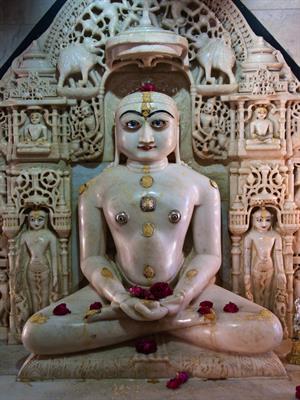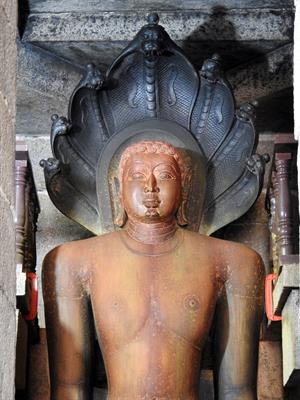PDF chapter test TRY NOW
Period before the advent of Jainism:
The Brahmin ideals dominated the scene of Northern India before the advent of Buddhism and Jainism. The Brahmin principles displayed stringent rituals and practices like prohibiting the sacrifice of animals, domination of ritual knowledge etc.
This dominant character of the Brahmin class led to discontent among the people of other classes, which pushed them towards the religions of Jainism and Buddhism.
The founders of Buddhism (Buddha) and Jainism (Mahavira) were contemporaries of Magadha kings Bimbisara and Ajatasatru. Cities like Rajgriha, Vaishali, Kushinagar developed and attained their glory under their reign.
Vaishyas: These are people belonging to the trade class who carried out economic activities and adopted Jainism to lift their status in society.
Jainism:
The tenets of Jainism are based on its teachers, whom they referred to as “Tirthankara’s”. The religion of Jainism had “\(24\) Tirthankara’s”, Rishabanath being the first of all the Tirthankaras.
Jain: The word “Jain” had been derived from the Sanskrit root word “Jina / Jaina” meaning the “Conqueror”. The religion Jainism is also considered older than the later religion Buddhism.
The Tirthankara’s hold a special place in Jain culture as their teachings enlightened the minds of the downtrodden people.
The greatest among the Jain Tirthankara’s is Mahavira \(24^{th}\) and the last Tirthankara). Parshavanath being the \(23^{rd}\) Tirthankara.
Vardhaman Mahavira:
Mahavira was born as Vardhamana Mahavira in \(539\) \(BC\), near Vaishali in Kundagrama. Born in Gnatrika (A Kshatriya clan), he was brave and an able ruler of his kingdom. He was married to Yasoda and also had a daughter named Anojja or Priyadarshana.

Vardhaman Mahavira
He renounced his family life at the age of \(30\) in quest of spiritual knowledge. Mahavira left his kingdom and undertook intense meditation, and adopted an ascetic life to attain Spiritual greatness.
Lion: According to the principles of Jainism, every Tirthankara or the teacher has been associated with a symbol and Mahavira was associated with the symbol of Lion.
After undertaking strenuous efforts to attain spiritual greatness for \(12\) years, Mahavira attained “Kevaliya / Kevala” (The Knowledge of the highest order) at the age of \(42\) under the Sal tree.
Post the attainment of Kevaliya, Mahavira came to be known as “the Jina” means the “conqueror of the self”. Later the followers of his method were called “Jains”.
To spread his ideas, Mahavira visited Magadha and Anga, the kingdoms of Bimbisara and Ajatasatru, respectively.
Tri-ratnas of Mahavira:
Mahavira explained the knowledge that he had acquired through intense meditation using three principles for understanding the commoners. These are known as the “Tri-Ratna or Three jewels of Jainism”.

Right faith: Believing and following the tenets of Jainism and Mahavira’s teachings.
Right Knowledge: Rejecting the theory of God’s existence and other Vedas and rituals.
Right Action: Denotes the five principles propounded by Mahavira in his teachings, namely:
1. Speaking Truth
2. Not to steal
3. Follow Ahimsa
4. Staying Honest
5. Displaying Kindness
The proliferation of Jainism:
Mahavira undertook numerous journeys in North India to spread his teachings and the ideals of Jainism. He was patronised by Chandragupta Maurya, Dhana Nanda of the Nanda dynasty and the ruler of Kalinga dynasty Kharavela.
The Jainist ideals challenged the stringent practices of Brahmins like Varnashrama and their rituals and hence gained a momentous following among the lower class people.
Jainism also believed that every object in the world has life and soul.
The Sects of Jainism:

During the later part of the Jainism History, different sects emerged within Jainism. These sects are said to be the by-product of a “Great famine” that struck the lands of Magadha, which forced a group of Jain people under the leadership of “Bhadrabahu'' to move towards the Southern parts of India.
Bhadrabahu: He is a Jainist scholar, well-known in history as the “Guru of Chandragupta Maurya”, the greatest king of the Maurya dynasty.
The famine that struck the Northern settlements lasted for \(12\) years. The group under Bhadrabahu in South India adopted rigorous practices during this period, while the Northern followers of Jainism took liberal traditions.
Jina Kanchi: Considered as the seat of South Indian Digambara Jainism. A Village named Thiruparthikundram in Kanchipuram was also once known as “Jina Kanchi” where the life of Mahavira was painted on the ceilings.
When Bhadrabahu returned to the North, he witnessed the change that had crept in that place, leading to the division of sects within Jainism.
The Fall of Jainism:
The dominant religion of Jainism saw the downfall due to the following reasons.
1. Lack of Patronage from the rulers.
2. Stringent practices followed by Jainism to attain Kevaliya.
3. The decline in Zeal among the Jain missionaries.
4. Split of factions among the Jainism and their dissimilar practices.
5. Insignificant ideas of Jainism (All things has life).
6. Emergence and widespread embracement of Buddhism.
Reference:
Shivram / Shutterstock.com
